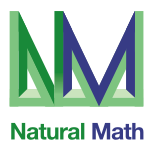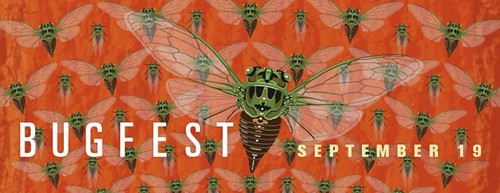Origami=math, Hacking Math teen course, scavenger hunt Sept 26: Newsletter September 21, 2015
Subscribe and read archives
Pinterest | Twitter | Facebook
In this newsletter:
- All ages: Origami = math?
- Teens: Questions and answers about the new Hacking Math course
- All ages: Join us for a free math scavenger hunt on September 26
Fold cicadas and read 6 reasons why origami=math

Parents and teachers often ask why we call this or that informal activity “mathematics.” Where is math in a puzzle, game, or craft? This year, we did origami at the annual BugFest, and got this question a lot. Why is origami good for your math?
Questions and Answers about the Hacking Math course

There is a lot of interest in the new Hacking Math course that we are starting this Saturday. Here are some questions and answers:
- Can I sign up if I will have to miss a meeting?
- Yes. We will record meetings and the recordings will be available to course participants.
- Can you help me with the price?
- We’d like to encourage you to share the course with a friend (using one computer during the meetings). It will help you split the cost, and improve your learning experience. Most people learn better when they program and discuss math with someone in person. Professionals call this approach “pair programming.” In the future, we will make courses more affordable by running multiple groups at once.
- What times are the meetings?
- 4 PM Eastern (New York) time on Saturdays, starting the 26th. Sorry we didn’t post the time before.
- Can my serious and interested 11-year-old take this course?
- Yes. Especially with friend or family help. Ages are always just guidelines. This will be at about formal algebra level.
- What number of hours per week do I need outside of the meetings?
- Probably 2-3 hours.
- Can I have a certificate of completion?
- Yes! We’ll even include course participant computer-generated art on it.
Second annual Sculpture Scavenger Hunt with Cary Visual Art is on September 26
On Saturday, September 26, 10 AM to noon, visit downtown Cary, NC! We will be on the main lawn by the Town Hall, near the sculptures. Cary Visual Art and Natural Math welcome families with children of all ages for a fun and thoughtful scavenger hunt, appreciating the sculptures on exhibit as part of the Cary Outdoor Sculpture Exhibition.
Do you live too far? We’ll post the scavenger hunt materials after the event, so you can run it at your own town!

RSVP to reach.out@naturalmath.com to participate in the event, or just show up.
Do you want to volunteer at Natural Math events (online or in the Research Triangle, North Carolina) and work with us to make math adventures happen? Write us at reach.out@naturalmath.com to talk! Children and grown-ups are welcome.
Dr. Maria Droujkova and the Natural Math crew
![]()
Posted in Newsletter
BugFest 2015: Why origami is math
Parents and teachers often ask why we call this or that informal activity “mathematics.” Where is math in a puzzle, game, or craft? This year, we did origami at the annual BugFest, and got this question a lot. Why is origami good for your math?

First of all, try the pattern we used. It’s a cicada, because this year is super-special for cicadas. The broods that emerge every 13 years and 17 years come out together! And how often does that happen, exactly? Wow, what rare event!

You’ll need a square piece of paper for this, and most paper comes in rectangles. What’s an easy way to make a square piece out of a rectangular paper? Of course, if you aren’t into bugs, you can find an origami pattern for anything you do like – superheroes or Jedi, robots or ponies, flowers or crystals, and so on.
If you’ve folded our cicada or another design, you know it takes a few decisions along the way. Do I use all paper layers or just some? Do I fold up or down? What angle do I choose at Step 7? If you play the (very very challenging) game of explaining an origami pattern by phone, you are sure to use a ton of math-related words. Up and down, triangles and squares, lined-up and perpendicular… When children hear math words in casual activities, it boosts their understanding of the subject. This is just one of the many math benefits of origami:
- If you talk about your origami, you are sure to bring lots of math words into your child’s life.
- Origami gives you hands-on experience of shapes, angles, lines, and geometric transformations. It’s a series of small geometric puzzles!
- Origami is an impressionist art. That’s why the folded piece is not a photo-realistic cicada. Instead, it shows the essence of the shape. This way, origami teaches us the art and craft of mathematical modeling, where you use simple parts to build complex stuff.
- Even young children want their folds to be precise, because nicely folded paper looks pleasant. Precision is a major value in mathematics. Origami teaches precision in a gentle and beautiful way.
- Paper is accessible and cheap. Paper craft invites you to mess with your project as you wish, to make mistakes, and to try this and that. Just like healthy math, where you make your own models, problems, and conjectures.
- Like all good math, origami can take your mind to a happy place. The headspace origami creates is focused and meditative. But when you figure out a difficult fold, it’s a burst of exuberant joy! Once you learn how, you can enter these states of mind to do other types of mathematics.

Posted in Grow
Online conference, BugFest, and Sculpture Scavenger Hunt: Newsletter September 5, 2015
Subscribe and read archives
Pinterest | Twitter | Facebook
In this newsletter:
- Join us at an online parenting and homeschool conference on September 8
- Free science-math-art family events in Raleigh and Cary, September 19 and 26
- Preserve the summer feeling: an article about Natural Math at home and outdoors
- Join the crew as an event volunteer
Free online parenting conference presentation: math is what you make of it
On September 8th at 2 PM Eastern time, Dr. Maria Droujkova will present online at one of the largest parenting and homeschool conferences. HECOA is inclusive of different kinds of families; read descriptions to see what does and does not fit with your views. To join, enter your name and email at the summit page: http://hecoa.com/nbts-speakers-and-workshops
Math is what you make of it: Designing, building, and modeling with Natural Math
You probably know at least one “Johnny who can’t count” – but overall people do more incredible science, technology, engineering, and mathematics than ever before in history. In the big scheme of things, we are doing great in math. But still there is a lot of pain and suffering.
As parents, how do we help our children grow their mathematical understanding, and see the beauty and joy of math? How do we use math as a source of freedom and power in our communities? How can we work through out own math grief? Let us figure it out, together.

BugFest free science and math event: September 19 all day in Raleigh, NC
Mark your calendars! Natural Math will be one of more than 100 local organizations and groups hosting activities at BugFest, the popular annual event at the North Carolina Museum of Natural Sciences in Raleigh. More info: http://bugfest.org/index.html
Bring your family to play with all the bugs, design insect fractals, and explore bridges between mathematics, arts, and sciences.
Here we are making origami butterflies at BugFest 2014:

Playing with math jokes at BugFest 2013: “Why did the ant cross the Mobius strip? To get to the same side!”

Second annual Sculpture Scavenger Hunt with Cary Arts on September 26
On Saturday, September 26, 10 AM to noon, visit downtown Cary, NC! Cary Visual Art and Natural Math welcome families with children of all ages for a fun and thoughtful scavenger hunt, observing the sculptures on exhibit as part of our Outdoor Sculpture Exhibition. Explore physical and virtual modeling techniques, enjoy the sculptures, and take guided tours.
Here is one of our Look and Make mini-posters with children’s creations at the Sculpture Scavenger Hunt 2014:

RSVP to reach.out@naturalmath.com to participate in the event.
Preserve the summer feeling with these playful activities
Several of our activities and principles were featured in the Noodle.com article Your Kids Will Love Doing Math This Summer (If You Do Too) by AK Whitney. From the article:
There’s no question that kids can be a tough audience and will quickly catch on to your attempts to educate them during their precious vacation. So don’t. Or at least, don’t seem like you are. Try the time-tested Socratic method. Instead of lecturing them, ask a question about the activity you are doing to encourage them to think about math.
“Ask, don’t show or tell,” Droujkova says.
You’ll be surprised to find that once you’ve gotten out of that show-and-tell mode, you’re more comfortable noticing how much math is out there, whether you’re shopping, planning a trip, or trying to stay on schedule.
Do you want to volunteer at Natural Math events, online or in the Research Triangle, North Carolina, and work with us to make math adventures happen? Write us at reach.out@naturalmath.com to talk! Children and grown-ups are welcome.
Dr. Maria Droujkova and the Natural Math crew
![]()
Posted in Newsletter
Playing 9 Apples with some boys!

Our family received the 9 Apples card game from Discovery Express Kids to try out. There are a lot of cards and the goal is to reach a target number each round. The cards are positive or negative, and there are also cards that allow you to switch the sign of a card. The rules reward you for using more cards to reach the target number. On the first round, you try to use cards to reach the number 9. Each round you work your way down until you have a target number of zero. The game ends when someone reaches zero.

First I tried out 9 Apples with my nearly seven year old daughter. She is my math lover! She enjoyed the game, but it was really the two of us working together to get the answers. She wasn’t able to do the multi-step addition and subtraction in order to reach the target number. She also struggled to switch the signs. But we enjoyed working together to make the longest row of cards possible. Next time, we’ll put a number line out and actually jump around with our finger using the cards to see how close we can get to our target number. I think this will help her practice the math and visually see what she is doing with each card. It would be even nicer if the card deck had a sturdy fold up number line in the box already. Using a number line would help kids of all ages see relationships and patterns in math more easily.
A few weeks after working with my daughter, I tried it out with my sons and some neighbors. I was a little nervous that my home-schooled boys wouldn’t be able to do the multi-step math as fast as their public-schooled friends. I needn’t have worried. All the boys did fine. The older boys were able to use more cards than the youngest (8 years old), but they all understood the game really quickly. They weren’t feeling competitive so I heard them giving each other ideas and suggestions about how to make the number they needed for the round. Things like, “Can I give him my change sign card? Then he can just add the six and four together and subtract the three so he gets seven.” It is nice to hear the thought processes going on in your kids’ minds! I was gratified to see my own sons’ math thinking ability, and their intuitive understanding of math.
I asked the kids for their likes and dislikes (in exchange for the cookies you see in the picture). They said it was “funner” than they thought, and that it was harder than they thought. The public-schooled kids said it was a lot more fun than worksheets!
I liked that it was a lot of math in a simple and fun way. I liked that the change sign cards gave it a lot of variety and dynamics. One drawback is the sheer number of cards. It’s a pretty fat deck of cards! I told the boys today that we’ll play it again with the booster pack of division and multiplication cards. Should have seen their faces!
Posted in Grow






